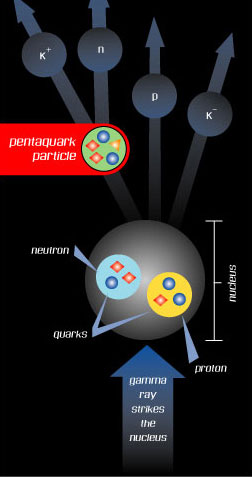Wonderful World of Pentaquarks: Information for the General Public

If you're reading this web page, then you likely know that atoms are the basic building blocks of matter, and that atoms are made up of electrons swarming around a tiny nucleus. More than 99.9% of the mass of everyday objects is contained within the nucleus of the atoms. Now the nucleus is made up of protons and neutrons, which in turn are made up of quarks. Because of this, most of your body mass comes from subatomic particles that are made up of quarks. Now, knowledge of quarks won't help you lose weight, but it does help scientists to understand other aspects of nature, such as why the sun shines. In fact, the sun's warmth comes from a process called fusion, which turns some of the mass of the nucleus into energy.
When we examine subatomic particles, we find all strongly interaction particles (for example, protons and neutrons in the nucleus) are made up of quarks. There are hundreds of subatomic particles known, and all of the experimentally well-established particles fit into only two categories: so-called baryons (made up of 3 quarks) and so-called mesons (made up of "two" quarks—really a quark and an anti-quark). What is the nature of the force between quarks such that only two types of quark matter can exist? Certainly, there is a mathematical hypothesis (or "theory") for the strong force, called Quantum Chromodynamics (or "QCD"), but in addition to baryons and mesons, the theory allows other configurations of quarks, such as so-called pentaquarks (made up of "five" quarks—really 4 quarks and 1 anti-quark).
Until recently, no firm evidence of pentaquarks existed even though physicists have searched for these objects (also known as "exotic baryons") for over 30 years. In 2002, the first announcement was made for evidence of the pentaquark at an international scientific conference in Osaka, Japan. In 2003, a report of this work was submitted for publication in a peer-reviewed scientific journal by a group of physicists known as the LEPS collaboration from an experiment done at the SPring-8 facility in Japan. Other evidence for the pentaquark has recently been reported by other experiments, with perhaps the strongest evidence coming from the accelerator at Jefferson Lab (Newport News, Virginia) by the group known as the CLAS collaboration. With the advent of strong evidence for a pentaquark by several independent experiments world-wide, there is good reason to believe that the pentaquark does, indeed, exist.
Why should anyone care that the pentaquark exists? This question is difficult to answer at the present time, because the discovery is so recent. Many of the modern conveniences and medical treatments have come from scientific discoveries in the past that did not seem very useful at the time they were discovered. The answer to the initial question is: we don't know what discoveries of today will be important tomorrow. However, this answer is too general. Let's speculate about why the pentaquark is interesting.
First, the pentaquark just announced is the first, clear-cut evidence for a subatomic particle with "five" quarks. This means we have a new classification of particle: the pentaquark (more precisely, an "exotic" baryon). As a possible analogy, consider the classification of living things into two categories, plants and animals. If a new type of animal were found that did not fit into any of the usual classifications (mammals, birds, reptiles, etc.) then this would be an exciting discovery for biologists. Now this analogy is not completely appropriate, as for many analogies, but perhaps you get the idea why a new classification is important. The first type of pentaquark has now been seen! We now have lots of work to do to understand more of its properties, and what this implies for our knowledge of the forces between quarks.
In summary, almost all of the mass of everyday objects is tied up in "quark matter". The warmth of the sun comes from conversion into energy of the mass of quark-matter particles like the proton and the neutron. The more we understand about the forces between quarks, the more we learn about various facets of nature. The pentaquark has eluded previous searches, but within the past year, there is new evidence that strongly suggests that the pentaquark exists. We don't yet know what applications this discovery might have, but this new particle will tell us more about the forces between quarks. At the least, we have found a new classification of quark matter, a particle (specifically, an exotic baryon) with "five" quarks.
Information Courtesy of Kenneth Hicks

